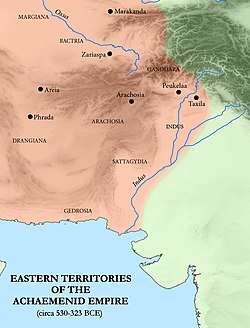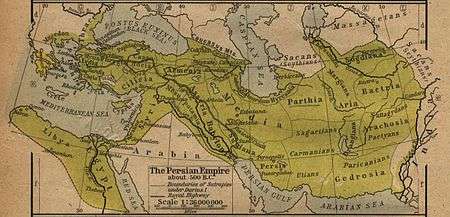Sattagydia


Sattagydia (Old Persian Thataguš, country of the "hundred cows") was one of the easternmost regions of the Achaemenid Empire, part of its Seventh tax district according to Herodotus,[3] along with Gandhara, Dadicae and Aparytae.[4][5][6] It is believed to have been situated east of the Kirthar Mountains on the Indus River, corresponding approximately to southern Indoscythia and to the current Sindh region of Pakistan. It was bounded on the west by Gedrosia, on the north by Arachosia and on the south and east by the Kingdoms of Ancient India.
History
Sattagydia is mentioned for the first time in the Behistun inscription of Darius the Great as one of the provinces in revolt while the king was in Babylon. The revolt was presumably suppressed in 515 BCE. The satrapy disappears from sources after 480 BCE, possible being mentioned by another name or included with other regions.[7]
After being conquered by Alexander the Great, Sattagydia became part of the Seleucid Empire. Under the Seleucids this area was adjacent to Sind, which was itself adjacent to Abiria (corresponding roughly to Rajasthan), with the coastal region being called Syrastrene.[8] The area was taken from the Seleucids by the Mauryans under Chandragupta in 316 BCE.[9][10] And, beginning in the 1st century BC, the area was incorporated into the burgeoning Kushan empire, referred to as "Scythia" in the Periplus.[8]
References
- ↑ "Susa, Statue of Darius - Livius". www.livius.org.
- ↑ Yar-Shater, Ehsan (1982). Encyclopaedia Iranica. Routledge & Kegan Paul. p. 10. ISBN 9780933273955.
- ↑ Herodotus III 91, III 94
- ↑ Mitchiner, Michael (1978). The ancient & classical world, 600 B.C.-A.D. 650. Hawkins Publications ; distributed by B. A. Seaby. p. 44. ISBN 9780904173161.
- ↑ Jigoulov, Vadim S. (2016), The Social History of Achaemenid Phoenicia: Being a Phoenician, Negotiating Empires, Routledge, p. 21, ISBN 978-1-134-93809-4
- ↑ Eggermont, Pierre Herman Leonard (1975), Alexander's Campaigns in Sind and Baluchistan and the Siege of the Brahmin Town of Harmatelia, Peeters Publishers, pp. 177–178, ISBN 978-90-6186-037-2
- ↑ "Sattagydians - Livius". www.livius.org.
- 1 2 Periplus of the Erythraean Sea
- ↑ De La Fosse, Claude Fraser, (1917) History of India (revised edition) Macmillan & Co., London, pp. 39-42, OCLC 13241962
- ↑ see also, Junianus Justinus Historiarum Philippicarum libri XLIV, XV.4.19
External links
- "Sattygydia" Livius: Articles on Ancient History
